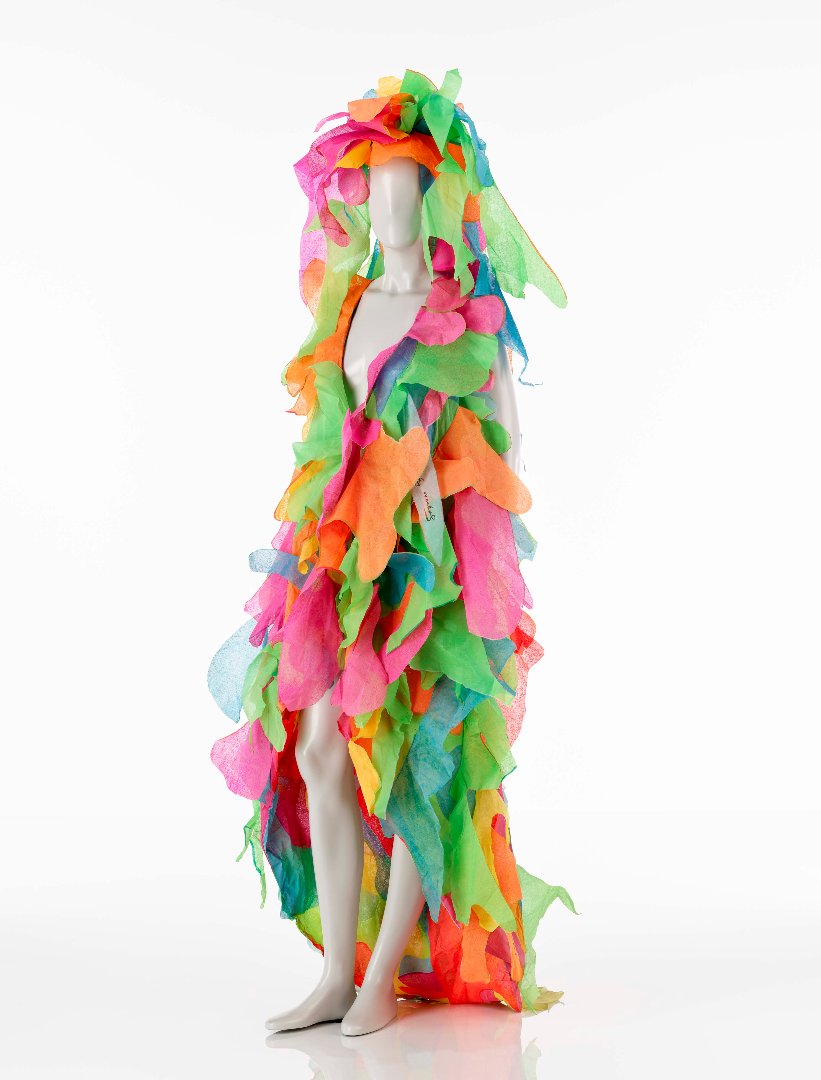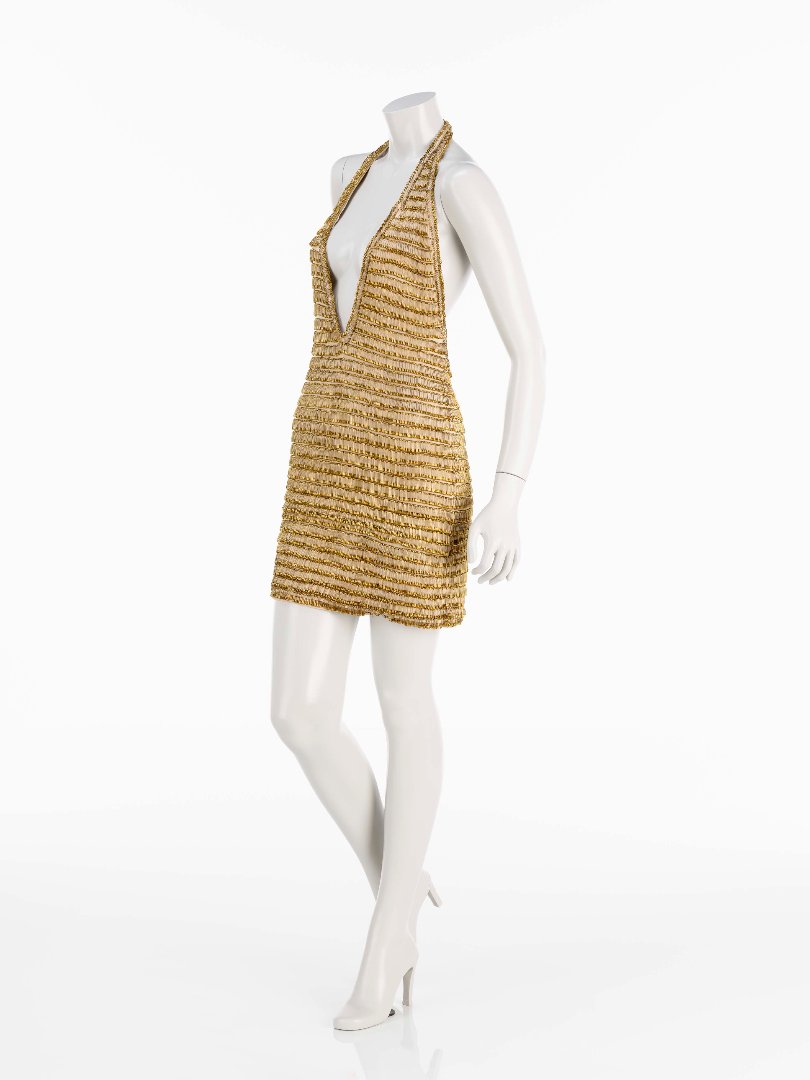Behind the Seams:Conserving the Sprouse Collection Long Term
The exhibition, Stephen Sprouse: Rock | Art | Fashion, is closed, but it is not forgotten—in fact numerous departments are coming together as you read this newsletter to deinstall the exhibition and prepare each artwork for long term storage as part of our permanent collection. Since most of these activities occur behind closed doors marked “Staff Only,” we thought this article was the perfect opportunity to open these doors and invite you to see behind-the-scenes.
First, let’s meet some of the numerous departments mentioned above.
Collections Support—This department of 15 is the team that brings plans to life. They are art handlers, mount makers, framers, painters, installers, overseers of art storage, woodworkers, metal workers, audiovisual specialists, and expert problem solvers.
Conservation—Conservation is responsible for the preservation of artworks, whether that be while on exhibition, in storage, traveling within the museum, or to other venues. Newfields has conservators who specialize in Objects, Paintings, Paper, and Textiles. Each specialization is required to know and anticipate the risks associated with each material and advise on how to mitigate or reduce these risks.
Registration—Registration oversees the logistics of everything. Yes. Everything. They manage databases, contracts, interdivisional communication, and they create the master schedule. Every time an artwork moves, they know when, where, and by whom and they update a database that tracks all this information. They know the what, when, where, how, and why for everything.
Leading up to the deinstallation of an exhibition, especially one as large and complicated as the Sprouse fashion exhibition, the interdepartmental team begins to meet regularly to determine what needs to occur and when. Colleagues in Registration take all this information and create a detailed schedule for the multi-week deinstallation of the over 200 artworks in the Sprouse exhibition, and notably the installation of over 100 artworks for the upcoming exhibition, Work in Progress: Conversations about American Art, both of which happen at the exact same time! The entire deinstallation process will require three to six people for seven weeks.

The space where the Sprouse exhibition was displayed is one of the museum’s most active and largest galleries, called the Allen Whitehill Clowes Special Exhibition Gallery. To have sufficient time to prepare for the upcoming exhibition in that space, The Message is the Medium: Contemporary Art, the team will need to remove the dressed mannequins from the gallery rather quickly. To safely accommodate this schedule, Collections Support will begin the deinstallation process by securing each dressed mannequin onto a moveable base, which was fabricated in the museum’s metal and woodshop. Once the mannequin is safely on its new base, three people will move a single mannequin into the basement of the museum, where it will receive attention from Conservators prior to its photography session.
Every Monday Conservators dust the galleries in the museum, and in the Sprouse exhibition this included the dusting of mannequins and fabrics. This isn’t just for cleanliness; dust is also actually really bad for artwork. Why? Because dust is a combination of fibers from clothes, dead skin cells, bits of insects, pollen, and other unpleasant things, and when dust is allowed to accumulate on a surface not only does it look bad, but it becomes an invitation for bad things to happen. First, dust—being a source of protein—attracts insects, who might keep eating their way through the dust to the textile. Secondly, dust can act like a sponge and hold moisture against a textile increasing the risk of color change and the breakdown of the fibers themselves. So, for many reasons, Conservation will clean the entire surface of the artwork with a specialized vacuum. Once everything is cleaned the mannequins will be professionally photographed by our Collection Photographer, Eric Lubrick, to record how each ensemble looked in the exhibition.

Then, each ensemble travels to a clean room where the artwork will be carefully undressed from the mannequin. Each piece will be placed in either an archival box or on a padded hanger. When a textile is stored in a box, rolls of tissue are placed inside each fold and between each layer. This padding helps protect the artwork from creasing and prevents fibers from breaking. With padding in place, only about three pairs of pants will fit comfortably into a storage box. The jackets and shirts will be stored on archival hangers that are custom padded out by Conservation staff. Unlike most hangers used in home closets, the hangers in the museum are 3-4 inches thick.
Once each ensemble is cleaned, photographed, and padded out for storage it will be rolled down the hallway on carts and placed in a huge art storage area where museum staff will monitor the temperature, light, humidity, and even look for bugs.
As a museum, it is our responsibility to preserve tangible artifacts with historical significance. Although many items are often safely tucked away in storage, they are ready to be borrowed by other museums in their special exhibitions, studied by students and scholars, and will be ready when invited out for display in their next exhibition.
Exhibition Credit:
Lead support for Stephen Sprouse: Rock | Art | Fashion is provided by Target, Absolut Vodka and the Jan B. Rubin Art Exhibition Fund. Generous in-kind support is provided by RALPH PUCCI International, KCD PR, and Louis Vuitton. Additional support is provided by Amy Curtiss Davidoff and David Phillips.
Image Credits:
Stephen Sprouse (American, 1953-2004), Andy Warhol (American, 1928-1987), dress, Spring/Summer 1988, synthetic fabric, acrylic paint. Indianapolis Museum of Art at Newfields, Gift of Joanne Sprouse and Bradford Sprouse in memory of Stephen Sprouse, 2021.69. © Stephen Sprouse.
Stephen Sprouse (American, 1953-2004), dress and shawl, Fall/Winter 1987, Lycra, brass safety pins, Indianapolis Museum of Art at Newfields, Gift of Joanne Sprouse and Bradford Sprouse in memory of Stephen Sprouse, 2020.26A-B. © Stephen Sprouse.




